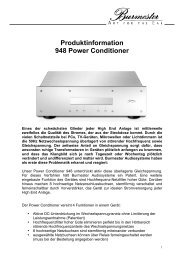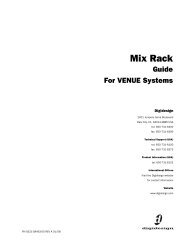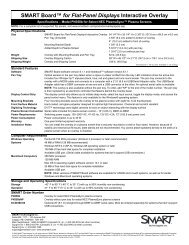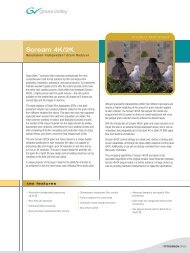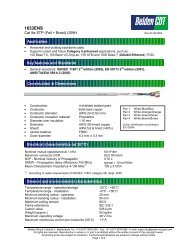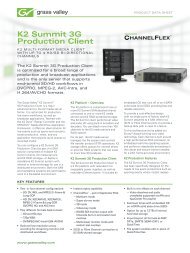Quickfly Operating Manual - Meyer Sound Laboratories Inc.
Quickfly Operating Manual - Meyer Sound Laboratories Inc.
Quickfly Operating Manual - Meyer Sound Laboratories Inc.
You also want an ePaper? Increase the reach of your titles
YUMPU automatically turns print PDFs into web optimized ePapers that Google loves.
Ratings for the cabinets themselves are detailed in the<br />
operating instructions supplied with that particular product.<br />
Please note that the pivoting lifting ring flying points<br />
are rated for a single point. Although the MRF-6 is<br />
attached using multiple points, this does not mean the ratings<br />
can be summed to calculate the frame’s safe working<br />
load. The frame provides distribution of the load over multiple<br />
points on the cabinet, which increases the strength<br />
beyond a single point, but it is still less than the sum of<br />
all of points of attachment. This is due to the limitations<br />
of the cabinet as well as the frame itself (Figure 10).<br />
4.6 TRANSITIONING TO L-TRACK-EQUIPPED CABINETS<br />
(OR THOSE FITTED WITH THE RFK-1 RETROFIT<br />
FRAME)<br />
L-Track is provided along the full width of the front and<br />
back of each MRF-6 rigging frame to allow L-Track<br />
equipped cabinets (or those equipped with the RFK-1 retrofit<br />
frame) to be hung underneath MRF-equipped cabinets.<br />
Each L-Track location on an MRF-6 frame is rated at 973<br />
lbs (442 kg). Each L-Track fitting (New Haven NH47556-12<br />
no ring) is rated at the manufacturer's recommended safe<br />
working load. Refer to the Working Load Limits section<br />
on Page 24 of the Appendix for their ratings.<br />
!<br />
Warning: L-Track connections must not be<br />
used to connect MRF-6s frame-toframe.<br />
Only MRFCB-6 Connecting<br />
Bars should be used.<br />
Max Working Loads:<br />
Total Supported Weight<br />
from the L-Track with<br />
both sides loaded:1940 lb<br />
(879 kg).<br />
485 lb (219 kg) from<br />
any single point.<br />
Figure 10<br />
Holes 1 and 2<br />
3620 lb (1642 kg)<br />
Max Working Load<br />
9<br />
4.7 BUILDING AN ARRAY<br />
For easy flying, as well as for adjusting for an array's center<br />
of gravity and setting of tilt angles, a series of pick-up<br />
points is arranged along the center structural member of<br />
the MRF-6 (Figure 10). Each point is differently rated to<br />
allow for variations in stress created by the different possible<br />
orientations. Each point can accept a 5/8" (3.25 US<br />
Ton) shackle and this in turn is offered up to a chain<br />
motor.<br />
!<br />
Warning: A single rigging point per column<br />
must be used when flying MRF-6equipped<br />
louspeakers.<br />
To build an array, place Type 6 loudspeakers (equipped<br />
with MRF-6 frames) on a flat surface or wheel dolly. Attach<br />
the rigging shackle to the desired rigging point on the<br />
central structural member. A column always must be raised<br />
from the center structural member of the MRF-6. Figure 10<br />
shows a comprehensive illustration of load limits for each<br />
of the MRF-6's pick-up holes. Be aware that the pick-up<br />
holes are not equally rated.<br />
The MRF-6 frames are primarily designed to be attached<br />
vertically to one another. Horizontal attachment is possible,<br />
but is provided for the sole purpose of keeping loudspeakers<br />
in good acoustic alignment and not provided for<br />
picking up an adjacent cabinet unsupported by its own rigging<br />
point. If frames are horizontally bolted together,<br />
Holes 3 through 8<br />
3100 lb (1406 kg)<br />
Max Working Load<br />
Center Structural Member<br />
Max Working Loads<br />
for Outer Members:<br />
1010 lb (458 kg) per side member,<br />
any hole.<br />
2020 lb (916kg) Total Supported Weight<br />
with both sides of a frame loaded.






